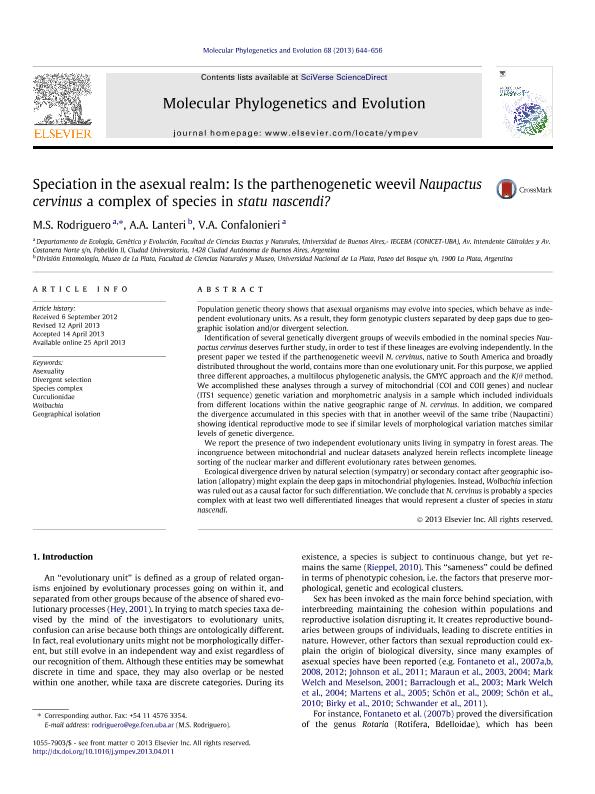Mostrar el registro sencillo del ítem
dc.contributor.author
Rodriguero, Marcela Silvina

dc.contributor.author
Lanteri, Analia Alicia

dc.contributor.author
Confalonieri, Viviana Andrea

dc.date.available
2017-08-16T23:21:18Z
dc.date.issued
2013-04
dc.identifier.citation
Rodriguero, Marcela Silvina; Lanteri, Analia Alicia; Confalonieri, Viviana Andrea; Speciation in the asexual realm: Is the parthenogenetic weevil Naupactus cervinus a complex of species in statu nascendi?; Elsevier; Molecular Phylogenetics and Evolution; 68; 3; 4-2013; 644-656
dc.identifier.issn
1055-7903
dc.identifier.uri
http://hdl.handle.net/11336/22549
dc.description.abstract
Population genetic theory shows that asexual organisms may evolve into species, which behave as independent evolutionary units. As a result, they form genotypic clusters separated by deep gaps due to geographic isolation and/or divergent selection. Identification of several genetically divergent groups of weevils embodied in the nominal species Naupactus cervinus deserves further study, in order to test if these lineages are evolving independently. In the present paper we tested if the parthenogenetic weevil N. cervinus, native to South America and broadly distributed throughout the world, contains more than one evolutionary unit. For this purpose, we applied three different approaches, a multilocus phylogenetic analysis, the GMYC approach and the K/h method. We accomplished these analyses through a survey of mitochondrial (COI and COII genes) and nuclear (ITS1 sequence) genetic variation and morphometric analysis in a sample which included individuals from different locations within the native geographic range of N. cervinus. In addition, we compared the divergence accumulated in this species with that in another weevil of the same tribe (Naupactini) showing identical reproductive mode to see if similar levels of morphological variation matches similar levels of genetic divergence. We report the presence of two independent evolutionary units living in sympatry in forest areas. The incongruence between mitochondrial and nuclear datasets analyzed herein reflects incomplete lineage sorting of the nuclear marker and different evolutionary rates between genomes. Ecological divergence driven by natural selection (sympatry) or secondary contact after geographic isolation (allopatry) might explain the deep gaps in mitochondrial phylogenies. Instead, Wolbachia infection was ruled out as a causal factor for such differentiation. We conclude that N. cervinus is probably a species complex with at least two well differentiated lineages that would represent a cluster of species in statu nascendi.
dc.format
application/pdf
dc.language.iso
eng
dc.publisher
Elsevier

dc.rights
info:eu-repo/semantics/openAccess
dc.rights.uri
https://creativecommons.org/licenses/by-nc-sa/2.5/ar/
dc.subject
Divergent Selection
dc.subject
Species Complex
dc.subject
Asexuality
dc.subject
Curculionidae
dc.subject
Wolbachia
dc.subject
Geographical Isolation
dc.subject.classification
Bioquímica y Biología Molecular

dc.subject.classification
Ciencias Biológicas

dc.subject.classification
CIENCIAS NATURALES Y EXACTAS

dc.title
Speciation in the asexual realm: Is the parthenogenetic weevil Naupactus cervinus a complex of species in statu nascendi?
dc.type
info:eu-repo/semantics/article
dc.type
info:ar-repo/semantics/artículo
dc.type
info:eu-repo/semantics/publishedVersion
dc.date.updated
2017-08-14T19:50:18Z
dc.journal.volume
68
dc.journal.number
3
dc.journal.pagination
644-656
dc.journal.pais
Estados Unidos

dc.journal.ciudad
Nueva York
dc.description.fil
Fil: Rodriguero, Marcela Silvina. Consejo Nacional de Investigaciones Científicas y Técnicas. Oficina de Coordinación Administrativa Ciudad Universitaria. Instituto de Ecología, Genética y Evolución de Buenos Aires. Universidad de Buenos Aires. Facultad de Ciencias Exactas y Naturales. Instituto de Ecología, Genética y Evolución de Buenos Aires; Argentina
dc.description.fil
Fil: Lanteri, Analia Alicia. Universidad Nacional de La Plata. Facultad de Ciencias Naturales y Museo. División Entomología; Argentina. Consejo Nacional de Investigaciones Científicas y Técnicas; Argentina
dc.description.fil
Fil: Confalonieri, Viviana Andrea. Consejo Nacional de Investigaciones Científicas y Técnicas. Oficina de Coordinación Administrativa Ciudad Universitaria. Instituto de Ecología, Genética y Evolución de Buenos Aires. Universidad de Buenos Aires. Facultad de Ciencias Exactas y Naturales. Instituto de Ecología, Genética y Evolución de Buenos Aires; Argentina
dc.journal.title
Molecular Phylogenetics and Evolution

dc.relation.alternativeid
info:eu-repo/semantics/altIdentifier/doi/http://dx.doi.org/10.1016/j.ympev.2013.04.011
dc.relation.alternativeid
info:eu-repo/semantics/altIdentifier/url/http://www.sciencedirect.com/science/article/pii/S1055790313001619
Archivos asociados
